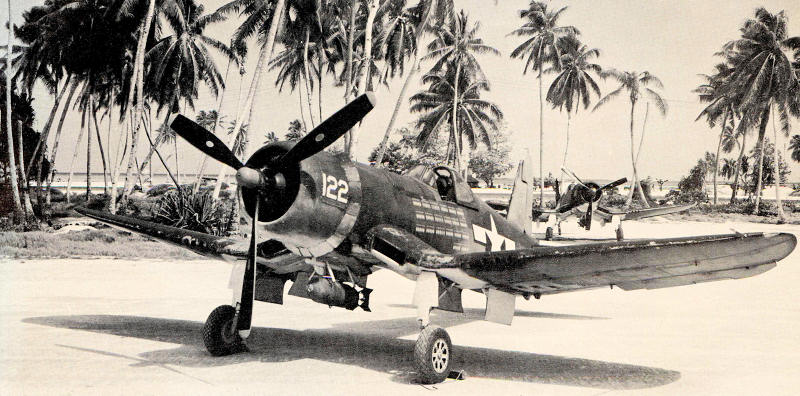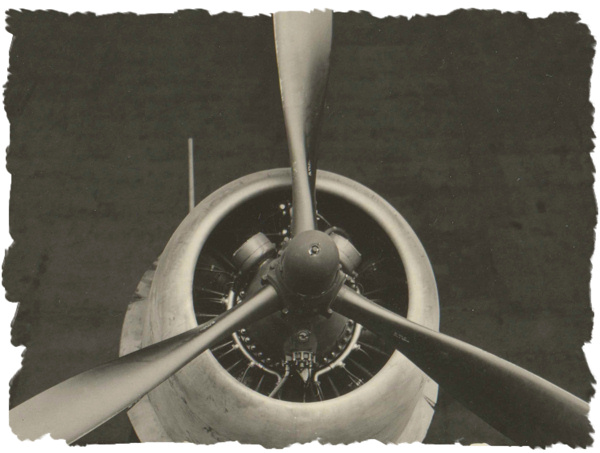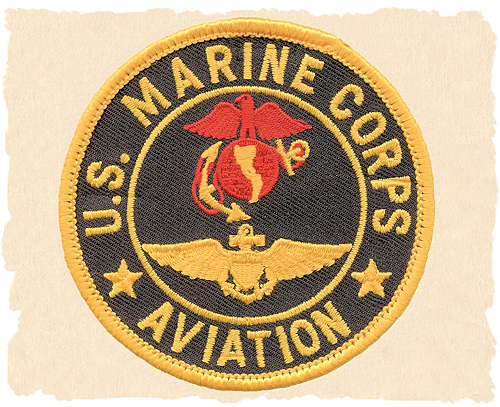VMF-224 Scrap Book
Chance-Vought F4U Corsair
Corsair Facts & Photos
The Chance-Vought F4U Corsair
The Vought F4U Corsair is considered by many to be the finest piston driven fighter aircraft of all time. Several outstanding fighter aircraft saw action during World War Two and aircraft enthusiasts often debate the merits of one aircraft over another. When it comes to the pilots who flew the F4U in combat, there is no debate, they would not have traded their Corsairs for any other fighter aircraft.
The development and operational history of the Corsair has been documented in many ways and there are links provided on this page for those who would like to further investigate the history of this amazing aircraft.
Listed below are a few interesting Corsair facts:
* The Vought Corsair was designed around an engine that didn't exist yet: the Pratt & Whitney R-2800 Double Wasp, a monster 18 cylinder double radial, eventually capable of 2,250 horsepower with water injection and, with the 13'4" diameter Hamilton Standard prop, the largest fitted to a fighter at that time.
* The Corsair is recognized as the first piston driven single-engine aircraft to exceed 400 MPH in level flight.
* The first production F4U-1 (BuNo 02153) flew June 25, 1942.
* The primary Corsair manufacturer was the Chance-Vought Company and aircraft were identified with a F4U designation. To help meet demand, Corsairs were also produced by Brewster, identified by a F3A designation, and by Goodyear, identified by a FG designation. For example, the F4U-1, F3A-1 and FG-1 were the same model of Corsair manufactured by the three different companies. Brewster would build 735 aircraft, Goodyear would build 4,007 aircraft, and Chance-Vought would produce the balance of the 12,571 Corsairs produced.
* After initial testing, and the Navy's rejection of the Corsair for carrier use, land based Marine squadrons were outfitted with F4U-1 aircraft.
* The Corsair would first see combat in early 1943 in the South Pacific followed a few months later by deployment with Marine squadrons in the Central Pacific.
* Results of a Fighter Evaluation Meet at Elgin Field in May of 1943 showed that the Corsair was superior to any Army fighter below 10,000 feet and were evenly matched from 10,000 - 20,000 feet. Above 20,000 feet the P-47 and P-51 held the advantage.
* Rushed into service in 1943, Marine squadrons would develop tactics and recommend aircraft modifications that would make the Corsair the aircraft of choice for all of Naval aviation by the end of 1944. Squadrons in the south Pacific refined the Corsair's air-to-air capabilities while squadrons in the central Pacific experimented and developed pin-point dive bombing and close air support tactics. By late 1944, the Corsair was recognized as an excellent multi-purpose fighter-bomber. In addition to being an effective tool to combat Kamikaze attacks against the American fleet, the F4U could accurately deliver bombs, rockets and napalm in support of ground troops. Marines and soldiers on the ground soon referred to the Corsair as the "Sweetheart of Okinawa".
* On September 13, 1944, Charles Lindbergh flying with MAG-31 squadrons based at Roi Island, flew the first Corsair to carry a 4,000 pound bomb load. He was successful delivering one two thousand pound, and two on thousand pound bombs in a single drop against an enemy gun position on Wotje Island.
* Corsair losses during WW-2: 189 lost in air combat vrs 2,140 enemy aircraft destroyed, 349 lost to enemy anti-aircraft fire, 230 lost due to operational problems during action sorties, 692 lost on routine flights and 164 lost aboard ship or on the ground. Fifty-six percent of Corsair losses were not related to enemy action.
* Surplus F2G "Super Corsairs" were purchased by several individuals in the mid-1940's and modified for air racing. The stock F2G, with it's 3,500 horsepower Pratt & Whitney R4360, 28 cylinder engine was the most powerful single engine, prop-driven fighter aircraft ever built. The race Corsairs of Cook Cleland and Richard Becker finished 1st and 2nd in the 1947 Thompson Trophy Race. Cleland would also take first place in the 1949 Thompson Trophy Race.
* April 21, 1951 - Corsair pilots Captain Phillip C. Delong and Lt. Harold Daigh were attacked by four YAK-9's over North Korea and shot down all four YAK aircraft. September 10, 1951 - VMF-312 Corsair pilot Captain Jesse G. Folmer during a strike mission over North Korea, shot down a MIG-15. Navy and Marine Corsairs were credited with ten aerial victories in Korea.
* The Corsair remained in production longer than any other WW-2 fighter with the last Corsair produced in 1952. During it's production, the Corsair underwent 981 major engineering changes and approximately 20,000 minor ones. Average production cost for the F4U was $75,000 per aircraft.
* F4U aircraft were used by the U.S. Navy and Marine Corps, the British Royal Navy, the Royal New Zealand Air Force, the French Navy, the Argentine Navy, the Honduras Air Force, and the El Salvador Air Force.
* During the 1969 "Soccer War", Honduras Air Force pilot Captain Fernando Soto flying his
F4U-5, shot down two FG-1 Corsairs and one P-51 Mustang flown by pilots of the El Salvador Air Force.
It is ironic that the last air-to-air combat involving a F4U would result in a Corsair shooting down another Corsair. This last Corsair combat would take place 26 years after the first Corsair saw combat with Marine squadrons in 1943.
* The last Corsairs to see military service were with the Honduras Air force and were finally sold to private sources in the late 1970's, over 35 years after joining the U.S. inventory.
Links to Corsair Sites
History of the Chance-Vought Corsair at F4U Corsair.com
Terry's F4U Corsair References at F4UCorsair.tld-productions.com
Vought F4U Corsair at AcePilots.com
Corsair Aviation Art at AviationArtHangar.com
Corsair Images
USMC Photo
F4U-1D number 122 assigned to Marine Air Group 31, VMF-111, was the only warplane known to receive an official citation after making 100 fighter-bomber missions without any mechanical trouble over a six-month period in 1944. The plaque affixed to her instrument panel stated:
"In accomplishing her 100 missions, Corsair 122 logged more than 400 hours flying time; her total hops, including tests and reconnaissance flights, reached an amazing total of 178. Built for air combat, Corsair 122 proved her versatility by accepting 1,000 pound bombs slung from her belly, and without strain or protest developed into the hottest dive bomber with wings. Were there blood in her fuel line instead of 100 octane, she would be wearing the Purple Heart; for the patch on the leading edge of her wing attests to the accuracy of Jap antiaircraft fire. She has covered all the Jap bases in the Marshall Islands like the morning dew."
<- (click to view)
<- (click to view)
<- (click to view)
<- (click to view)
<- (click to view)






